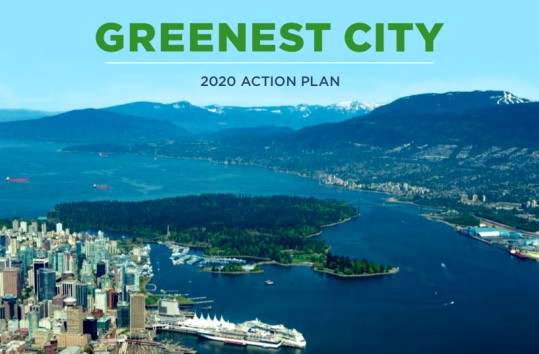Our Latest Blogs
Our Solutions News Blog was envisioned to gather and share information from the very best to help you and your business to become more effective.
Our Solutions News Blog was envisioned to gather and share information from the very best to help you and your business to become more effective.


British Columbia's pioneering carbon tax has been remarkably effective in reducing fuel use, with no apparent adverse impact on the province's economy. This conclusion comes from a new study by Sustainable Prosperity soon to be published in the upcoming issue of Canadian Public Policy.
The study's key findings suggest that since the carbon tax took effect (July 1, 2008), BC's fuel consumption has fallen by 17.4% per capita (and fell by 18.8% relative to the rest of Canada). These reductions occurred across all the fuel types covered by the tax, not just vehicle fuel.
In terms of economic impact, the study findings suggest BC's GDP kept pace with the rest of Canada's over that time, and the tax shift enabled BC to have Canada's lowest income tax rates (as of 2012).
Overall, concludes the study, the tax shift has benefited all taxpayers in that cuts to income and other taxes have exceeded carbon tax revenues by $500 million from 2008-12.
BC brought in North America's first carbon tax in July 2008 and imposed a price on the use of carbon-based fuels. The tax was a central component of BC's climate change strategy, which aims to reduce GHG emissions by 33 percent below 2007 levels by 2020.
The carbon tax was designed to be "revenue neutral", meaning that all revenues were to be used to reduce other taxes, mainly through cuts to income taxes (personal and corporate), as well as targeted tax relief for vulnerable households and communities - resulting in no overall increase in taxation.
The tax was initially set at $10 per tonne of carbon dioxide equivalent (CO2e), but the price was designed to rise by $5 per year thereafter until it reached $30 per tonne (roughly 7 cents per litre of gas) in 2012.
The Sustainable Prosperity study notes that when the carbon tax was brought in, there were predictions that it would harm BC's economy. Now, four years later, the data show that BC's economy has slightly outperformed the rest of the country over the period that the carbon tax has been in place.
So too, notes the study, the ultimate goal of BC's carbon tax is to reduce GHG emissions, by taxing the fossil fuels that cause them. Data on GHG emissions is available only through to 2011, so changes in fuel use (available through 2012) were used as the most current indicator of the tax's effects.
To get a fuller picture on GHG reductions the study compared GHG emissions in BC to emissions in the rest of Canada, counting only those sources that are subject to the BC carbon tax. From 2008 to 2011, BC's per capita GHG emissions associated with carbon taxed fuels declined by 10.0 percent, which the report's authors describe as a substantial reduction.
During this period, BC's reductions outpaced those in the rest of Canada by almost 9 percent. These GHG reductions were similar to those seen in fuel use during this same 2008-11 time period.
The study concludes that on the basis of available evidence, BC's carbon tax has been a highly effective policy to date, contributing both to a significant reduction in fossil fuel use per capita, with no evidence of overall adverse economic impacts. However, it cautions, further economic analysis is needed to reach more firm conclusions about these effects and their causality.
Research conducted by GLOBE Advisors confirms many of the Sustainable Prosperity conclusions, in particular that the carbon tax has helped various stakeholder groups from government, First Nations, educational institutions, and in the private sector to rethink the way they operate and to consider investing in clean technologies or to adopt more environmentally-friendly or lower carbon intensive practices.
The GLOBE Advisors research also suggests that while having a carbon tax provides positive benefits to the province, sustained leadership from both the public and private sector is required to meet the continuing challenge of further reducing the province's carbon footprint and growing BC's clean economy.
This is particularly so given that the carbon tax could be more than carbon neutral, revenue neutral, but could also be used to provide measurable, performance-based improvements for all BC residents and businesses.
The Sustainable Prosperity study notes that the BC experience to date is consistent with the results witnessed in seven European countries that brought in carbon tax shifts in the 1990s, notes the study. In those countries, the tax shifts caused estimated GHG emission reductions ranging from 2 to 7 percent (over a decade or more), according to a major empirical study funded by the EU.
It cautions that BC's carbon tax shift is only 4 years old, so it is too early to draw firm conclusions. But its GHG reductions are trending in the same direction as those seen in European countries with more than 15 years of date. However, it points out, BC's reductions to date appear to be even greater, which is consistent with the fact that its carbon tax rate is now higher and more comprehensive than in most European countries.
Stewart Elgie, Professor of law and economics at University of Ottawa, and the study's lead author, said "BC's experience shows that it is possible to have both a healthier environment and a strong economy -- by taxing pollution and lowering income taxes."
Canada's premiers are meeting from July 24-26 to discuss a proposed Canadian Energy Strategy which includes "a more integrated approach to climate change," Elgie added. "I hope that BC's success will inspire Canada's premiers to show leadership on a national approach to pricing carbon pollution."
His point is well taken. As reported recently in the Globe and Mail, studies undertaken by Environics Research and more recently the Environics Institute shows that a majority (59 per cent) of Canadians outside of B.C. would support the introduction of a B.C. style carbon tax in their own province, a proportion that has been slowly building over the past four years.
Majority support for such a tax was expressed in all provinces except Alberta (at 43 per cent), and is most widespread in Quebec (67 per cent), followed by Manitoba (59 per cent), Saskatchewan (58 per cent), Ontario (58 per cent) and Atlantic Canada (54 per cent).
The Sustainable Prosperity study is available for download Here »
Source: Globe-Net

Vancouver City Council received an update today on the Greenest City Action Plan (GCAP), and heard that the City has achieved a four per cent reduction in greenhouse gas emissions since 2007, while Vancouver’s economy and population both grew significantly.
“The 2013 update on the Greenest City Action Plan shows we’re making good progress, but there is much more to do,” said Mayor Gregor Robertson. “The costly impacts of climate change require us to continue working hard and strengthening our partnerships with other levels of government, business and labour communities, and our neighbourhoods and residents.
“Cities around the world are grappling with the effects of climate change, and in Vancouver we’re proving that you can have a strong, healthy economy while reducing carbon pollution. The climate crisis is a daunting global challenge and Vancouver’s leadership shows other cities what can be achieved, so it’s crucial that we keep raising the bar.”
The 2013 GCAP report to Council included an update on the 10 goals outlined in the plan, which collectively strengthen Vancouver’s natural environment, create new economic opportunities, and further establish Vancouver’s reputation as a city that balances economic growth with environmental leadership.
The accomplishments outlined in the report include:
In addition to these accomplishments, Council heard about the significant work ahead that is necessary to achieve the ambitious targets in the Greenest City Action Plan. From local food production and security to green transportation, access to nature and a lighter footprint, the 10 GCAP goals call for local and international leadership. They set out a clear path towards a bright green future for our community and our planet.
To learn more about the plan and read the 2013 GCAP Implementation Update, or to see an interactive map of green projects in Vancouver, please visit Vancouver.ca/greenestcity »
Source: Vanvantage.com

Golder Associates Ltd. and the Union of Nova Scotia Municipalities' (UNSM's) Municipal Sustainability Office are launching a new guidebook - From Great Ideas to Great Communities - to help municipalities implement their Integrated Community Sustainability Plans (ICSPs).
This guide will help municipalities to translate their long-term goals and ideas into meaningful action on the ground.
The guide demonstrates how municipalities can build a culture of sustainability and integrate sustainability goals and principles into their daily operations and decision-making. Designed to be practical and easy to use, it includes a seven-part framework for action, step-by-step guidance, and priority strategies and actions for moving forward with the implementation process.
"We want each and every one of our municipalities to be successful in reaching their sustainability goals, and we anticipate that this guide will serve as a roadmap to help them along the journey," declared Councillor Frank Fawson, Municipality of the District of Lunenburg and Chair of UNSM's Sustainable Practices Committee.
The guide was prepared by Chris Lindberg and his team at Golder Associates Ltd. with support from The Natural Step Canada. It draws on examples and resources from various municipalities in Nova Scotia and across Canada that have had success with implementing their ICSPs.
"Nova Scotia has demonstrated real leadership in working with its municipalities on sustainability planning," says Senior Sustainability Specialist at Golder Associates and lead-author Chris Lindberg.
"We're very excited to launch this guide and help accelerate the implementation process. While the guide focuses on Nova Scotia, the framework, process and practices are relevant for municipalities all across Canada. We're looking forward to working with municipalities to make sustainability happen in their communities."
The guide and a wide variety of supporting resources are also available for download here »
Source: Globe-Net

Natural Resources Canada (NRCan) is undertaking an R-2000 Net Zero Energy pilot (the Pilot) to recognize builders and homes reaching net zero energy performance in Canada, and to pilot the next generation of NRCan's 2014 R-2000 Standard and EnerGuide Rating System in net zero energy applications.
Drawing on NRCan's systems and infrastructure - including its certified energy advisors certification process and quality assurance protocols - will provide recognized metrics, objectivity, standardization and credibility to this emerging space.
In addition to doing a field trial of the next generation standards, NRCan will use the pilot to examine the best means for seamlessly incorporating net zero energy offerings into its suite of standards on a permanent basis.
NRCan will also use this opportunity to explore possibilities surrounding net zero energy ready homes.
Design Seminars and Request for Proposals
The Pilot will be implemented in several phases over the next two years.
The next step in the Pilot process is a design seminar on May 15, 2013that will present NRCan research that demonstrates that an R-2000 home can achieve net zero energy home performance using commodity technologies and methods, as well as provide a cost ball-park, guidelines and starting point for those interested. The design seminar will take place via webinar.
A request for proposals (RFP) for participation in the Pilot will be issued following the design seminar in May. It will be open to any builders from across Canada that are interested in piloting the standard to build and certify their houses to this ultimate level of energy performance.
The RFP is designed to evaluate the merit of the applications. It is expected that a maximum of 10 applicants will move through the RFP stage. These applicants will then need to provide detailed house designs and modelling results to complete the design stage.
Where necessary, NRCan will work with participants to develop modelling workarounds should the HOT2000 simulation software not contain a model for proposed products or equipment.
The RFP will close on mid-late June, followed by an RFP evaluation. The Design stage will last from early August to the end of October. Finally, construction and labeling will take place from November 2013 to November 2014.
An ERS "Efficient Living Assessment" will be completed on each house to obtain as-operated energy performance after occupants have moved in. Lastly, post-program analysis will be undertaken to allow NRCan to formalize within its suite of standards "R-2000 Net Zero Energy" recognition, and potentially "R-2000 Net Zero Energy Ready". It will also provide valuable lessons-learned to interested builders for the future.
Background information about the Pilot
NRCan has committed to using a Standards Council of Canada based process to develop the next generation standards for R-2000, ENERGY STAR for New Homes and the EnerGuide Rating System (ERS) to ensure open and transparent processes and input from stakeholders.
Over 500 stakeholders have participated in these processes over the past three years. NRCan is now looking to test those standards with respect to net zero energy homes.
The R-2000 Standard will form the basis for the pilot. Houses labelled under the Pilot must meet the requirement of the draft2014 R-2000 Standardand obtain a rating of zero gigajoules using the new ERS scale.
The Pilot will also focus on off-the-shelf technology (i.e. engineered pre-packaged systems rated to an internationally-recognized performance standard) in order to advance the commoditization of net zero energy homes in Canada.
Why use R-2000 and ERS as the basis?
R-2000 is an established national standard with the training, certification, house-testing, inspections and overall quality assurance that are an essential part to ensuring the integrity of net zero energy housing/
The minimum envelope requirements of the draft2014 R-2000Standardwill be applied in order to ensure the building envelope and other long-term elements are well-addressed before renewable energy technologies are used to offset conventional energy use.
The R-2000 builder community has long been the group of experts advancing energy innovation in home building, and this Pilot, along with the next generation standards, will help to reinvigorate and bring together again this community of leaders, coalescing the R-2000 and Net Zero communities.
Using the next generation ERS rating scale offers an ideal opportunity for participants to use and feed into the next generation ERS process to ensure it addresses any outstanding issues that relate to net zero energy homes.
Benefits of participating
Builders will have a first to market claim on this new Government of Canada certified level of recognition from NRCan. They will also play a key role in setting the requirements for labelling Net Zero Energy homes in Canada. NRCan will offer technical support and promotion as an in-kind contribution to each participant.
Pilot participants will also benefit from collaborating with leading experts to gain insight into design of homes using available, high performance building envelope products, technologies, and techniques that can be used to achieve net zero energy performance.
Participants who are successful through the request for proposals process will also have access to modeling support from NRCan simulation experts for technologies that cannot be modelled using HOT2000.
This pilot will give participants an opportunity to demonstrate industry leadership with first-to-market, NRCan-recognized net zero energy homes built and certified under the quality assurance of R-2000. NRCan will also work with the pilot proponents to raise awareness about the pilot and its participants.
Source: Globe-Net

The first home in Canada qualified under the new ENERGY STAR® for New Homes (ESNH) Standard was unveiled last week in Guelph Ontario.
The custom home, built by Sloot Construction Ltd., is located in Phase II of the Hale's Manor community in Guelph.
Attendees at the unveiling were provided with a pictorial overview of the energy-efficient features of the home and an airtightness test demonstration, one of the stringent criteria for qualification under the ESNH Standard that also requires the inclusion of energy-saving features such as:
The ENERGY STAR® for New Homes initiative was developed by Natural Resources Canada to help the public easily identify homes that are approximately 20 per cent more energy efficient than those built to minimum building codes.
To receive the ENERGY STAR® qualified label, homes are inspected to ensure they meet the technical requirements for energy efficiency developed by the Government of Canada. Each ENERGY STAR® qualified home is third-party verified by Certified Energy Evaluators, and labelled by EnerQuality, a licensed Service Organization.
The ENERGY STAR® name and symbol are registered trademarks of the United States Environmental Protection Agency (US EPA) and are administered and promoted in Canada by Natural Resources Canada.
"The home building industry, led by innovators like Sloot Construction, continues to demonstrate its capacity to aim higher and do better," said EnerQuality's Corey McBurney. "The new national standard raises the bar for better-built homes, and sets a benchmark that is readily achievable by both custom and production residential builders."
"In five years, this Standard will be the 'new normal', as it will inform the Ontario Building Code minimum requirements," McBurney continued.
Building codes around the world are moving quickly toward low-carbon and carbon neutral performance standards. The National Energy Code for Buildings in Canada recently published the first generation of outcome-based codes for Canada, which is in the process of being adopted by several provinces nationwide.
Retrofitting existing homes and buildings for energy efficiency is a largely latent market which has been highlighted by many policy makers as a primary means by which to create jobs while reducing community energy consumption and greenhouse gas emissions.
GLOBE Advisors is currently working on a project in British Columbia on behalf of utilities and the provincial government to develop a strategy for further developing the home energy performance industry in that province - a strategy that will focus largely on increasing consumer demand for retrofit activities and catalyzing industry support for related activities and services.
Municipal building codes (where relevant) are also raising the bar for energy performance of the building stock.
In Vancouver for example, the Greenest City Action Plan has established a 2020 goal for all new buildings to be carbon neutral and the existing building stock as a whole is to be 20 per cent more energy efficient. Achieving this goal requires a shift to performance-based codes and to a building design approach which focuses on a building's envelope first.
Source: Globe-Net

The Climate Change and Emissions Management Corporation (CCEMC) is seeking innovative ideas from around the world for a $35 million open innovation challenge that will create new, carbon-based products and markets. The grand challenge is the first ever initiated by an organization in Alberta.
It is expected to identify multiple technologies that could provide significant reductions in greenhouse gas emissions by transforming carbon from a liability into an asset.
The CCEMC is seeking novel solutions for innovative carbon use - bright ideas at any stage of development that are rooted in solid science. Focus areas include, as examples, processes that produce high value goods from greenhouse gas emissions, technologies that fix captured carbon into solid or readily transportable starting materials, high-value materials with high carbon content that could be produced from greenhouse gases and biological processes that capture or consume carbon and convert it into a new viable product, such as the creation of oils from algae.
"We are witnessing how industry-wide open innovation and collaboration can dramatically accelerate and improve environmental performance in the oil sands, a key economic driver for Canada," said Dr. Dan Wicklum, chief executive of Canada's Oil Sands Innovation Alliance (COSIA).
"The Grand Challenge represents a unique opportunity to bring the same kind of leading-edge thinking to the development of new technologies to unlock the potential of Canada's energy economy in an environmentally responsible way."
Submissions are open at www.ccemcgrandchallenge.com and technical solution providers are encouraged to register now to signify their interest.
Read the Full Story Here »
Source: Globe-Net

Download Reports
Overview
GLOBE Advisors undertook six months of research in 2012 examining three high-growth sectors in British Columbia's clean economy - specifically Clean Energy Supply and Storage; Green Building and Energy Efficiency; and Clean Transportation. From this research, GLOBE Advisors published three market reports - one on each of these three key sectors.
These reports build on GLOBE's West Coast Clean Economy study released in March 2012 and provide critical insights on job creation and investment promotion opportunities in British Columbia. The job numbers presented in the reports were quantified using updated and proven methodologies that allow for the identification of industries and occupations that are part of these sectors in B.C.
Secondary research and employment estimates for this study were backed up by extensive consultation and outreach activities, including more than 90 in-depth interviews with industry leaders from successful B.C. companies, academic institutions, government agencies, and non-governmental organizations. The interviews were designed to identify current trends, economic development opportunities and challenges, and employment demand and supply issues.
In addition, GLOBE Advisors was involved in organizing a one-day "Green Workforce Development Symposium" alongside the City of Vancouver, the Vancouver Economic Commission, and six public post-secondary institutions in March 2012 that was designed to explore current and potential future employment opportunities and challenges in BC's clean economy.
Source: Globe Advisors

The global transition to a low-carbon economy is underway and firms that supply low-carbon goods and services can thrive in this expanding market.
But for Canada to thrive in a low-carbon context, governments need to act now to set the appropriate policy signals so that businesses can position themselves to be competitive and can tap into this market.
These are the conclusions of a new report the National Round Table on the Environment and the Economy (NRT) released today entitled Framing the Future: Embracing the Low-Carbon Economy, billed as the first report to broadly consider how Canada needs to position itself with respect to low-carbon goods and services markets in order to prosper through the global transition to a low-carbon economy.
"A low-carbon economy is no longer a concept of the future. Governments around the world are moving ahead, and a number of jurisdictions already have formal low-carbon growth plans in place," said National Roundtable Interim Chair, Robert Slater.
"While governments need to put in place the conditions that will stimulate innovation, mobilize investment, enhance market access, and foster talent and skills development, private interests need to drive the process, engage with governments, and play a leadership role in developing a vision for Canada's low-carbon future."
The report seeks to quantify the potential low-carbon market opportunities; assess and characterize the risks to Canada in the transition to a low-carbon future, including quantifying the risk of emissions lock-in; and to put forward a framework for governments and the private sector to work collectively to ensure future prosperity in a carbon-constrained world.
Planning for low-carbon growth can also help navigate any trade, market access and emissions lock-in risks during the process of reducing the emissions intensity of our economy.
The report says the global market for low carbon goods and services could grow from $339 billion (2010) to between $3.9 and $8.3 trillion per year by 2050. If Canada were to retain its current average share of the global economy for these sectors in 2050, domestic low carbon production would reach between $70 and $149 billion per year.
Sending the right policy signals is a pre-requisite for broad low-carbon growth and to help reduce the economic risks associated with accessing and trading in this market, according to the report.
Examples cited included border carbon adjustments, low-carbon fuel standards, and help to limit the costs of meeting long-term climate change mitigation objectives.
Not sending strong policy signals now could result in inefficient investments in carbon-intensive assets and infrastructure over the next decade warns the report. Meeting our emission reduction targets would then end up costing Canada in the range of $87 billion by 2050 as a function of both the increased quantity of emissions and increased per unit cost of emission reductions due to stranded assets, it states.
"Canada needs a low-carbon growth plan, and with this report the NRT has put forward a strong foundation for it. Based on extensive research and stakeholder consultation, the NRT framework for low-carbon growth positions Canada for long-term prosperity," said Slater.
The NRT's low-carbon vision Canada in 2050 is as a nation of:
It also sees Canada as a nation where:
Getting to this ideal state requires actions along four basic lines, says the report.
FIRST, federal and provincial governments need to stimulate low-carbon innovation.
SECOND, public and private sectors need to mobilize investment in low-carbon infrastructure and technology.
THIRD, federal and provincial governments need to enhance Canadian firms' access to fast-growing low-carbon markets.
FOURTH, federal and provincial governments need to work together to foster low-carbon talent and skills development.
The key messages of the NRTEE report echo the findings of research carried out by GLOBE Advisors over the last year in Canada and the United States.
GLOBE has identified five key sectors at the "core" of the low-carbon economy that have been responsible for driving growth of a cleaner economy throughout the West Coast region of North America (more here).
GLOBE suggests that accelerating investment and job creation in the low-carbon economy will require continued government leadership through supportive public policies, programs, and procurement; improved public education and engagement; innovative business and financing models, greater efforts to promote collaboration and knowledge transfer; and improved access to skilled labour, education, and training.
Framing the Future is the sixth and final report in the NRT's Climate Prosperity series examining the economic risks and opportunities of climate change to Canada. The National Roundtable is to wrap up its operations soon based on decisions taken in the last federal budget.
Source: Globe-Net
 |
|